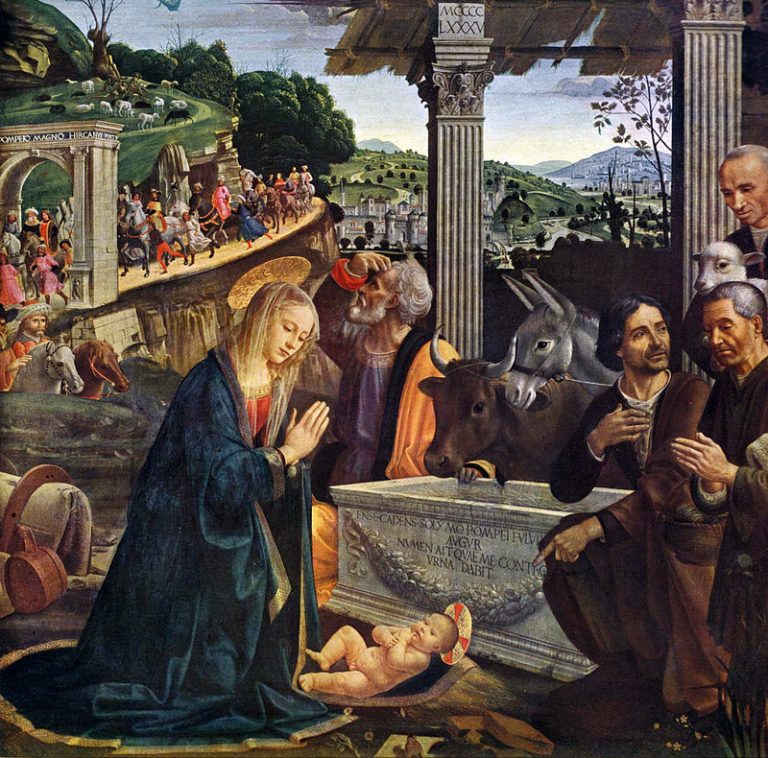By Madeleine Stebbins

Domenico Ghirlandaio, one of the great Renaissance artists, painted this masterpiece for the Sassetti Chapel in the Basilica of Santa Trinità in Florence. Later the young Michelangelo became his apprentice. Ghirlandaio’s painting was probably inspired by the Flemish artist Hugo van der Goes’ Portinari Altarpiece in its attention to detail and its realist handling of the three shepherds on the right, the one with brown hair being the artist’s self-portrait.
The Adoration of the Shepherds is superbly rich in detail and symbolism. However, rather than unravel its marvelous complexity I will try to discern its overall spirit and what its beauty tells us of another world.
It is all about the Mystery of the Incarnation, the event of God becoming man, which, because it is so great, mind-boggling, and above our reason, is the main enormous stumbling block for practically all non-Christians. It is as if the artist here says (and succeeds): Let us try in our human way to give an inkling of the sweetest, the loveliest, the most tender, and—yes—the most amorous thing that ever has happened or ever will happen—the apogee of beauty and joy. This beauty is a witness to truth.
Donald DeMarco wrote: “The Incarnation—Christ becoming man—attests to the merging of heaven and earth. . . . The Russian existentialist Nikolai Berdyaev maintains ‘In the creative artistic attitude towards the world we catch a glimpse of another world.’”
In this painting, though the divine Infant is in the center and Mary is to His left, she looms large as the centerpiece of that beauty, earthly and unearthly. She spreads her grace, also symbolized in the expanse of her mantle, to all around her. Her very beauty is the opening to the sacred. She is indeed the gate of heaven. From her flesh the Word became flesh. His DNA comes exclusively from her. She is the threshold. It is noteworthy that she does but one thing: she adores the Word, the Son of God, drawing the shepherds and us into her adoration and her total focus on Him, the helpless Infant, whose power will conquer and save the world.
O fairest among women . . . / Thy cheeks are beautiful as the turtle dove’s / Thou art all fair, O my love, and there is not a spot in thee . . . / Draw me: We will run after thee to the fragrance of thy ointments. (Song 1:7, 9; 4:7; 1:3)
The ointments are of the Holy Spirit. The delicacy of Mary’s veil; her chaste eyes cast down; the gentle and tender bent of her head; the reverence of her hands in prayer; the humble kneeling, loving posture of her whole body over her Child all convey an inner world of moral goodness, purity, and holiness—an invincible goodness which ultimately overcomes all evil.
The throng on the left in a riot of colors is following the Magi, running eagerly and joyfully. St. Joseph looks up to the angel and the star. The beasts are painted like the touching creatures of God that they are. They are somehow in adoration. In the background is the holy city, Jerusalem. All of nature—sheep, horses, meadows, distant hills, trees, flowers—is in a festive mood. On earth all that waits for the Messiah has reached the fulfillment of its hope. Everything sings.
Winter is now past, / The rain is over and gone . . . / The flowers have appeared in the land . . . / The voice of the turtle dove is heard in our land. (Song 2:11–12, Douay-Rheims)
Madeleine Stebbins is the author of Looking at a Masterpiece and Let’s Look at a Masterpiece: Classic Art to Cherish with a Child. These poignant works bring timeless truths to life through the beauty of art.